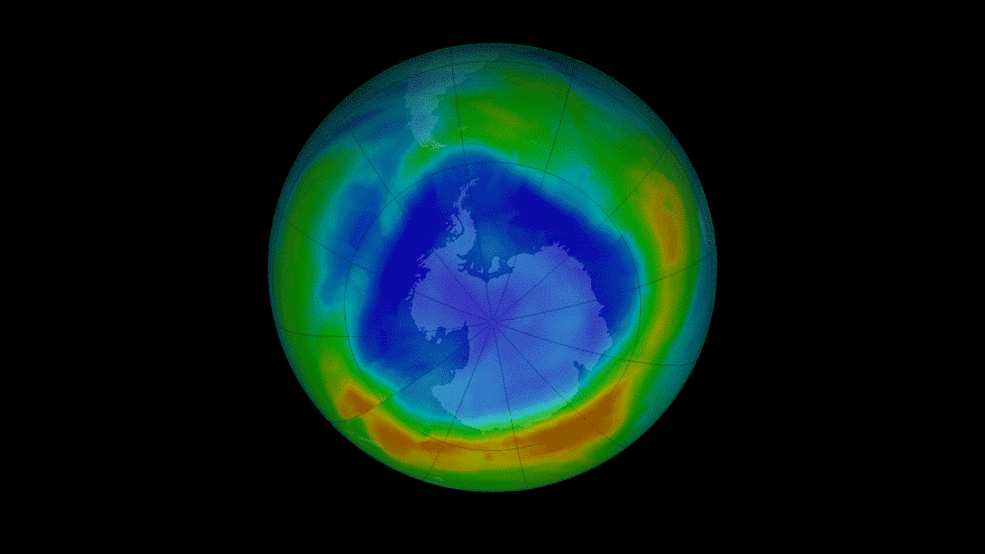The story of the ozone hole’s recovery has been met with some new, less promising analysis. New research has indicated that the ozone hole has been remarkably huge and long-lived over the past four years, suggesting it might not be on track for recovery in the coming decades as previously hoped.
On the other hand, certain researchers in the field aren’t convinced by the study and believe that the ozone hole’s recovery is still looking promising, despite a few unlucky blips in recent years.
In the new study, scientists at the University of Otago in New Zealand carried out a trend analysis on the ozone hole’s daily and monthly fluctuations between 2004 to 2022, concluding the ozone hole has been “remarkably massive” over the past four years and now contains much less ozone gas in the center of the hole compared to 19 years ago.
“This means that the hole is not only larger in area, but also deeper throughout most of spring,” Hannah Kessenich, lead study author and PhD candidate in the University of Otago’s Department of Physics, said in a statement.
The ozone layer is a region of the stratosphere between 15 and 30 kilometers (9.3 to 18.6 miles) above the Earth’s surface that has a higher concentration of the gas ozone compared to other parts of the atmosphere. It acts as an invisible shield for our planet, absorbing much of the Sun’s harmful ultraviolet rays.
In the 1970s and 1980s, scientists discovered a hole in the ozone layer above Antarctica, sparking one of the biggest environmental worries of recent times. It transpired that the layer was being worn away by chlorofluorocarbons (CFCs), human-made chemicals used as refrigerants and solvents that can act as ozone-depleting substances after they are wafted up into the stratosphere.
The South Pole’s ozone hole is constantly in a state of movement and flux, growing and shrinking in tune with the seasons. The ozone hole increases in size from August to October when the Southern Hemisphere enters spring and temperatures start to rise. It continues to grow until around mid-October when the temperatures warm to such an extent that the polar vortex weakens and finally breaks down.

The size of the ozone hole fluctuates with the seasons and has significant variability year-to-year, making it tricky to measure.
Image credit: NASA
In recent years, there have been many reports that the hole in the ozone layer appears to be shrinking and may be on track to totally recover within a few decades, primarily thanks to the successful phase-out of CFCs.
This latest analysis argues that this optimistic vision might not necessarily be the case. Instead, they argue climate change appears to be driving new sources of ozone depletion, causing the hole to swell.
However, other researchers in this field believe the new study might be overstating the problem. The hole in the ozone layer varies from year to year due to a wealth of different factors, which some scientists believe the latest analysis by the University of Otago doesn’t fully account for.
As one example, January 2022 saw the eruption of the Hunga Tonga-Hunga Ha’apai, a colossal underwater explosion that pumped a significant amount of water vapor into Earth’s atmosphere and may be having an impact on concentrations of ozone in the stratosphere. The data from 2022, therefore, is skewed due to this freak event in a way that’s not representative of the bigger picture.
Many other factors like this might be at play too.
“I am not convinced of the results of the study,” Dr Martin Jucker, a lecturer at the University of New South Wales and Associate Investigator at the ARC Centre of Excellence for Climate Extremes, said in another statement.
“Their results rely heavily on the large ozone holes we have seen in 2020-2022. However, existing literature has already found reasons for these large ozone holes: Smoke from the 2019 bushfires and a volcanic eruption (La Soufriere), as well as a general relationship between the polar stratosphere and El Niño Southern Oscillation: We know that during la Niña years, the polar vortex in the stratosphere tends to be stronger and colder than usual, which means that ozone concentrations will also be lower during those years. The years 2020-22 have seen a rare triple La Niña, but this relationship is never mentioned in the study,” Dr Jucker explained.
The new study is published in the journal Nature Communications.
Source Link: The Ozone Hole Isn't Recovering After All, A New Study Argues